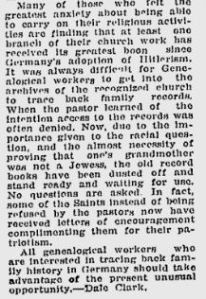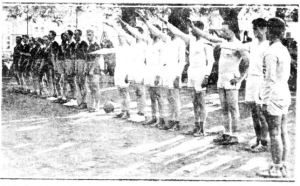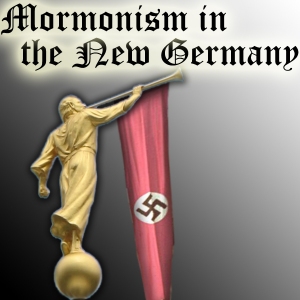Mormonism in the New Germany
By David L. Steed
“They are to hold the keys of this ministry, to unlock the door of the Kingdom of heaven unto all nations, and to preach the Gospel to every creature.” -Joseph Smith Jr.
In December of 1933, a newspaper article was written in the Church News section of The Deseret News. The title of the article was “Mormonism in the New Germany.” This article praised the new regime of Adolf Hitler and sought to compare the glory of LDS teachings with the new doctrine of Nazism that was spreading across the German nations. The article’s author, Dale Clark, was not the only Mormon to openly praise Hitler and Nazi Germany. Many other Mormon publications, including The Millennial Star, were used to compare and contrast Mormonism with Nazi Germany.
The first correlation of the LDS church with Nazism centered on the dynamic leader of Germany, Adolf Hitler. He was charismatic, strong, dedicated to his beliefs, a great orator, and was widely viewed as a savior figure to the Fatherland. Many Mormons could appreciate the qualities of a figure like Hitler, as these characteristics were the same ones valued in a General Authority of the Church of Jesus Christ of Latter-Day Saints. Those traits continued to stretch into more concrete beliefs that Latter-Day Saints could identify with, namely the Word of Wisdom.
Dale Clark described Hitler’s dedication to principles found in Doctrine and Covenants section 89 in the following manner:
There is another noticeable trend in the “Mormon” direction. It is a very well known fact that Hitler observes a form of living which “Mormons” term the “Word of Wisdom.” He will not take alcohol, does not smoke and is very strict about his diet, insisting on plain and wholesome foods, largely vegetarian.
When compared with verses from section 89 it is easy to understand how Clark came to that conclusion:
5 That inasmuch as any man drinketh wine or strong drink among you, behold it is not good…
7 And, again, strong drinks are not for the belly, but for the washing of your bodies.
8 And again, tobacco is not for the body, neither for the belly, and is not good for man…
10 And again, verily I say unto you, all wholesome herbs God hath ordained for the constitution, nature, and use of man—
11 Every herb in the season thereof, and every fruit in the season thereof; all these to be used with prudence and thanksgiving.
12 Yea, flesh also of beasts and of the fowls of the air, I, the Lord, have ordained for the use of man with thanksgiving; nevertheless they are to be used sparingly;
His praise continues; Clark focuses on the product of obeying a Mormon lifestyle. He shows that due to Hitler’s clean living he has a superior mind and body that allowed him to rise above the struggles of the great depression in Germany. His dynamic leadership and choosing to live the principles of the Word of Wisdom have set an example for the youth. This insinuates that as a result of obeying a higher law that Hitler has been blessed by God:
“These two colorful leaders (Adolf Hitler & Joseph Goebbels) of the new Germany, in their gigantic struggle for political supremacy have needed capable bodies and clear brains and have trained like athletes. Their very popularity is making intemperance more unpopular. The fact that they are worshiped may be one big reason for a growing dislike for smoking and drinking in Germany today.”
These are not the only comparisons that Clark draws between Mormon doctrine and Nazi culture. Under the direction of Hitler, National Socialism seeks to care for the needs all German citizens, much like the welfare programs of the church. Clark describes one of the new programs implemented by Hitler as an idea that has long been a central component of the LDS religion and thus further proof that Germany is preparing itself for the Gospel:
“Their trump card to show the originality and political genius of the Hitler party was the brilliant method they have under taken to put over the charity drive for this winter. To them it was phenomenal; to the friend, however, it was just another application of the effective method that has been in use in the ‘Mormon’ church for decades. The Nazis have introduced ‘Fast Sunday.'”
The German version of Fast Sunday is incredibly similar to that of the LDS Church. The fast is implemented on the first Sunday of the month and asks those that can afford it to forgo two meals in order to collect funds to feed the needy in the country. The idea behind this special fast was to build unity and alleviate the the suffering of those within Germany.
Clark was not the only one to make the comparison to “Fast Sunday.” Several of the LDS missionaries documented the practice in their journals and came to the same conclusion. One such missionary, Sanford Bingham, wrote in his journal in 1936 the following account documenting just one of the many missionaries’ first-hand accounts of how Nazi Germany compared to the religion they were trying to preach:
“A number of interesting parallels can be seen between the church and some of the ideas and policies of the National Socialists . . .The similarities between Mormons and Hitler ranged from views of the family, the importance of marriage, the strength of the educational system, the courage of the Mormon pioneers, the sense of the Word of Wisdom, the wisdom of a fast day to help the poor, the value of youth programs and the need to do genealogy.”
The Mormon publication The Millennial Star also printed their comparison of the two programs, showing unique but united Mormon perspectives from around the world on Naziism:
“It is indeed singular that a comparison of the details of the two systems of organized fasting shows them to be so nearly identical. Perhaps that part of the message of the Restored Gospel may have been directly or indirectly the inspiration and the model for the new scheme adopted by the German Government—perhaps not. But evident, at least, is the fact that consciously or unconsciously, the people of the world are discovering that the Lord’s way is best. The leaven of the Gospel is spreading.”
The comparisons between the two systems extended beyond the Word of Wisdom. Programs such as the Hitler Youth were directly correlated to the Boy Scouts, a staple of Mormon youth. Womens organizations in the church have their counterparts as well; Young Women’s Mutual Improvement and the Relief Society are Bund der Deutschen Madel and Frauenschaft, respectively.
Clark continued in his article to emphasize the similarities with the genealogical program of the church. As the new idea of Aryan bloodlines began to surface in Germany, genealogical work for German families needed to be performed to prove their purity. Genealogy having already been recorded for decades in Mormon households set the Saints apart from their neighbors. The German government now set up genealogical facilities making it easier than ever before to find family records. The German members of the church were also recognized as patriots for their exceptional record-keeping:

As Hitler came to power, like most dictators, he sought to consolidate that power for himself. Most religions were openly attacked and outlawed, but Mormonism was allowed to thrive. Missionaries continued to share their message with others as other minority sects such as the Jehovah’s Witnesses were banned.
While touring the European missions President Heber J. Grant visited the church members in Germany. He recognized the privilege that the Nazis were granting the saints to continue to practice their religion. There were minor exceptions to what could be taught, of course, as rhetoric concerning Zion or the New Jerusalem would not be permitted. President Grant saw an opportunity and instructed the saints to “Stay here. Keep the Commandments. Try to get along the best you can, even under some limitations. We want to keep the Church intact and the missionaries working.”

The Church then went on a campaign to align itself with the Nazi government and draw paralellels between the two ideologies. The Church magazine in Germany, Der Stern, emphasized that the Mormon Senator from Utah, Reed Smoot, was a longtime friend of Germany. Later, another article was written in the official paper of the Nazi party, Volkischer Beobachter, by the mission president of the East German Mission, Alfred C. Rees.
Rees did his best to draw comparisons between the plight of early Mormonism and the struggle of the Nazi party:
“The Mormon people know what persecution and suppression mean. And the German people who have gone through the shadow of the valley since the World War; and who have been forced to rely upon their own strength and determination, and upon their undying belief in their own ability to restore their self-respect and their merited place among the mighty sisterhood of nations, reveal that same progressive character, which does not shun obstacles. For that reason, to a student of Mormonism, recent developments in Germany present a most impressive comparison.”
Looking back on these statements it is hard to imagine that a church of God would align itself with some of the most despicable leaders of the past century. It is a lesson, however, in how the Church should conduct itself in other nations and with other cultures. As the Church continues to grow and expand their missionary efforts in other countries, they must be prepared for unsavory and hostile governments. The Church’s past diplomatic strategy has previously been defined by the twelfth Article of Faith: “We believe in being subject to kings, presidents, rulers, and magistrates, in obeying, honoring, and sustaining the law.” By tacitly endorsing rulers like Hitler and the Nazis, it forever tarnishes the image of the Church in places like Germany, where such endorsements are not quickly forgotten.


Thank you for bringing this to our attention! Insidious.
this comes as no surprise. The Mormon church always comes out on the wrong side of history. Did you know when given the choice to either be a free territory or a slave territory Brigham Young chose slavery. He supported the right of people to own slaves. There were even a few slaves in the early pioneer caravans that crossed the plains and there is record of tithing being paid with slaves. they have a corrupt moral base and therefore do not posses the ability to recognize true good from evil.